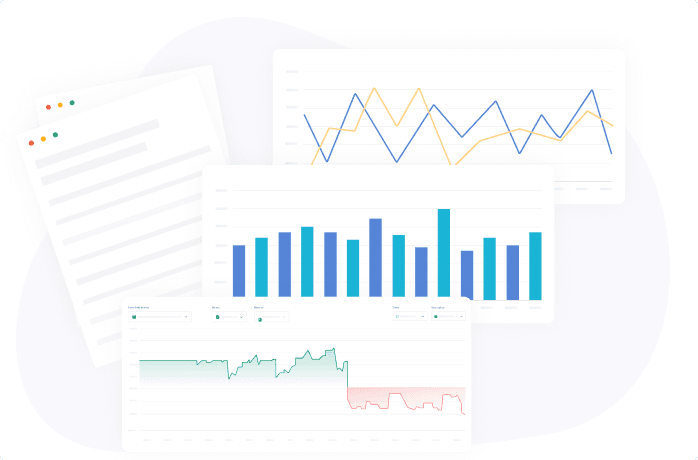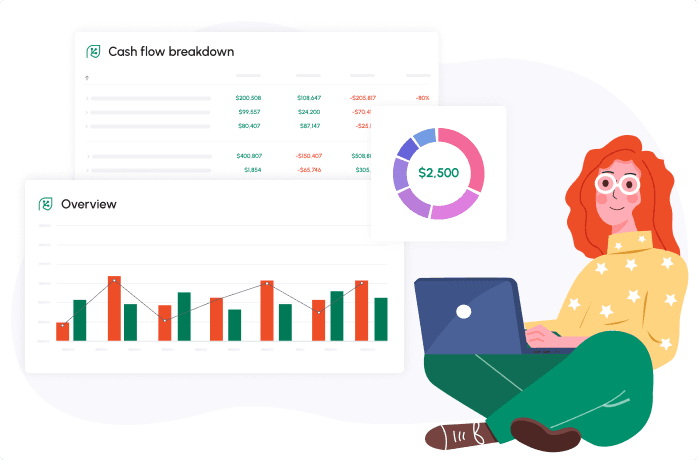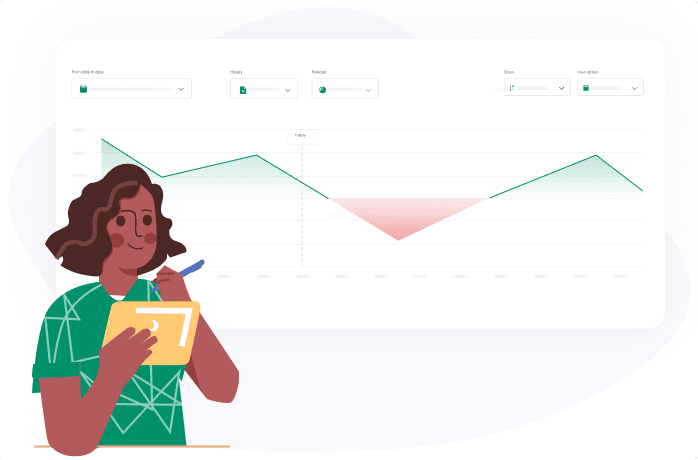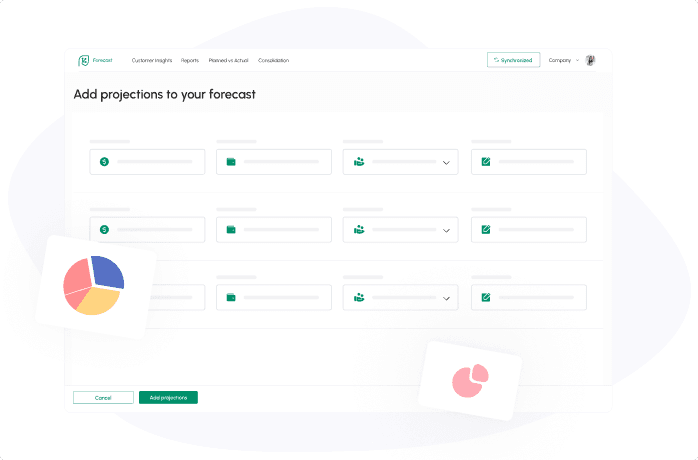
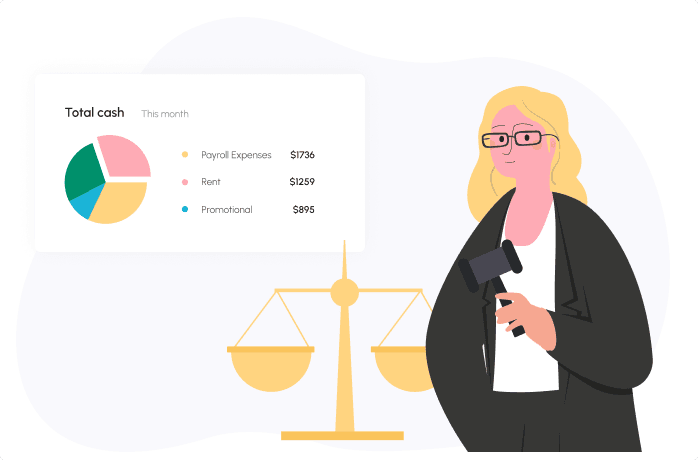
Every legal firm knows the drill. Things are going well, your client base is growing and you can grow your expense base. Or can you?
Can you count on your expected revenues from clients and use these funds to grow your headcount? Maybe invest some of the money in infrastructure? Or maybe you should save the funds for a rainy day or wait a bit until you have more stability and clarity to make that call? How should you regard a single big payment you expect to receive? How should credit be treated? Do clients pay for your services on time? Is your credit system performing well?
The good news are that you are not alone. Almost every law firm and attorney experiences these same doubts. The better news is that there’s a tool to help you take educated decisions that will help you optimize your growth while avoiding hindrances and pitfalls. This tool is called Cash flow forecast or cash flow planning.
In this article, we are going to tell you everything you need to know about creating a cash flow forecast for legal firms and businesses. We are going to go through the definitions, the tactics and the tips that will allow you to better prepare to whatever outcome and the methods to do so more effectively.
If you are new to cash flow forecasting, you might want to read the entire article. If you are experienced you can skip ahead for the parts you are less familiar with.
What is cash flow planning
What are the benefits of planning ahead What should you avoid doing when cash flow planning Tools for cashflow forecasting Cashflow forecasting for legal firms – the specifics Cash flow summary – what have we learned What is cash flow planning Cash flow planning is the practice of building a forecast of your expected cash turnaround, including revenues and expenses. Business owners use cash flow management tools to forecast how much cash on hand will they have in the future.
The backbone of cash flow planning
Cashflow planning is reviewing the expenses and incomes of the past, taking into account the expectations of how they will look in the future and formulating it all together into a model or a scenario that forecasts your cash in the a specific time period in the future.
The expenses
On the expenses side, your cash takes into account every payment you make. This means each payroll expenditure, each bill you pay, every credit card transaction and each financial payment you make. You don’t have to be an accounting wizard to understand what these mean – just look into the payments and fees you pay, the bills and the invoices and you will have something to create a budget from. They are the basis of your cash flow management and offer a good approximation of the expenditures around the corner.
The revenues
Exactly like with the expenses side, past revenues are your best indication of your revenues to come. The exact payment date for each payment is also an important factor to consider.
Attorneys that charge process is based on clients paying retainers have more predictability than attorneys whose fees are success based. If you have a big deal expected you can add it as a scenario and attach a probability to it.
Revenues also come from various sources. First and foremost are the fees your accounts and clients pay for your services but other assets of yours can contribute to the payment side as well. Forecasting the likelihood that you get paid by clients is one of the best practices you can use.
Mix it all up and create a scenario As mentioned, you build your cash flow based on the past outcomes you’ve had, every fee and every income are considered. However, you must consider the opportunities as well as the threats that may happen. Maybe you can hire someone who will take care of your business development and will increase your revenues and payment ratio, but maybe they will fail to do so successfully and you will be stuck with the expense. Or maybe a pandemic would hit and your revenues will drop. Everything can happen and you need to have some sort of sensitivity analysis to know whether your business can survive such events.
Scenario types
There are various scenarios you should create. Each scenario has a different likelihood and should be taken with different severity, but it’s a good business practice to look into various scenarios so nothing comes as a total surprise. The better you are aware of possibilities the more likely you are to survive hard times and take advantage of opportunities. Here are a few of the most common scenarios:
Base case scenario
This scenario assumes business as usual. Expenses will stay more or less the same, your client base also wouldn��’t grow or shrink too much. This is based, almost entirely, on the past.
Worst case scenario
The worst case scenario is the script from doomsday. This is a scenario that helps you prepare for the day that a lightning struck your top employee, your insurance company has gone bankrupt and a new pandemic broke and immediately cut your revenues in half. Worst case scenarios have a very low chance of coming through, but preparing for them is critical and helps you become more resilient and even shows ways to save money.
Best case scenario
As the name indicates, these are ideal outcomes you theoretically can accomplish. Their importance (other than putting a smile on our faces) is in understanding the associated costs and demands of such opportunities. For example, if you believe you can add a new client, it might mean you need extra employees, manage a bigger office space, up your infrastructure etc. Thinking about these and cross referencing them with the actual payment and revenues such a client might bring may bring up unexpected results.
Specific scenarios
These type of scenarios are an important tool to navigate your business ahead. They let you evaluate the effects of specific actions you can take (e.g. opening a new office in another city, getting a payment for a big deal you negotiated). They are specific by nature and unlike the previous scenarios that should be conducted periodically, these ones should be made only when there’s a specific question in mind.
Timing of scenarios
As mentioned above, most scenarios are created regularly, every month or every quarter so you can plan ahead. Specific scenarios are created when you have specific opportunities and questions in mind.
Time frame of scenarios
The best practice is to create scenarios for various time frames. For the next quarter, next year and next 3 years are one of the most common time frames used.
Bigger legal firms tend to plan ahead for longer periods but in any case the most appropriate time frame depends on your goals, client base and competitive environment.
What are the benefits of planning ahead
Like the joke about the blind people describing an elephant, the main benefits of cash flow planning depend on where you come from. Some businesses are more defensive and would like to prepare for a rainy day, while others would like to keep the reserves ready for opportunities. Other are more opportunistic and want to make sure every dollar is spent on growth.
Avoiding pitfalls
Law firms are often more reliant on when and how their clients pay than most financial businesses. If the economy or specific sector you are specializing in is taking a downturn your revenues will suffer. Creating your cashflow forecast can be the difference between getting ready for a negative event and getting hit by it.
A properly created cashflow forecast can be your law firm’s life line because it will allow you to act fast and act precisely when push comes to shove.
Such cashflow forecasts are naturally more focused on expenditures and decreases in revenues and payments. They must factor the risks for the short term and the long term, the probability to get paid when the economy is down, your clients are bleeding, credit is scarce and collections are hard. A good cashflow plan will also factor the payment due date for key clients so you can make sure you always have cash on hand and don’t need to way for the clients to pay.
Seizing opportunities
When your law firm is more opportunistic it understands that being able to add some fuel to the fire at the right time can considerably grow your business and client base. Such a law firm will plan ahead to always have the needed flexibility. This will make sure you do not need to wait for the collection process to happen or to get invoices paid because you are always ready with the right amount of liquidity in your system.
Optimizing to the last cent
Some of the most successful law firms are always optimizing their expenditures and bills. This doesn’t necessarily mean minimizing them. It sometimes means spending every available dollar on your budget on growth so you constantly scale up your business, hire new employees or partners for your team and add new paying customers. Managing such an operation is a risky economic endeavor, but the returns are considerable. A good cashflow planning will make managing such an operation easier and more effective.
What should you avoid doing when cash flow planning
There are a few biases that we all have that will impair our ability to conduct a proper cash flow forecast. We tend to be over optimistic, forget the past and under evaluate risks.
Note: when you are using a professional cashflow forecasting tool, many of these biases become irrelevant since the algorithm gives you an objective result free from such biases.
Don’t be over optimistic
It is easy to be swept off your feet thinking of a potential deal, but when collection time arrives billing might not go as smoothly as expected. A new client that is sure to join might get a better offer from their current law firm and stick with them. Always try keeping your feet on the ground and when factoring big changes add their probability of occurring. This will keep your available funds and money forecasts accurate.
Remember your past
We didn’t mean to be dramatic, but seriously, remember the past. It is the best predictor of the future. If billing was hard during last fall, expect it to be the same this fall as well. If money is tight when hiring a new VP it is likely to happen again. There’s a small chance your office rent will decrease. Being radically aware of the past and keeping track on actual costs is your best bet when managing your cashflow.
Don’t undervalue risks
Many of us avoid thinking about negative outcomes. Thinking about mistakes and downturns take their toll on our psyche. However, when planning ahead you must pay attention to risks so you will not get caught unprepared.
Another practice that is harmful is undervaluing risk. If there’s a risk a client will leave you, make sure you understand the exact damage your collections will take and the effect on your accounting.
Tools for cashflow forecasting
We all understand the importance of cashflow planning but where do we start? It’s a meticulous job that you need to get right and you can’t afford making mistakes. In this segment, we are going to go over your best options to create your firm’s cash flow the right way.
A dedicated spreadsheet model
If you understand the importance of cash flow, there’s a good chance your law firm created a spreadsheet file with such a model. This is definitely a valid option, you just need to follow a few guidelines
Use accurate data
Make sure the data you use is up to date and include accurate financial data. The past is the best predictor of the future so make sure all financial data is exact.
Don’t overload the file A good scenario is an easy to read scenario. Make sure your excel is easy to read, easy to understand and easy to act upon. Otherwise, your entire work was in vain.
Make sure you are presenting the right conclusions and the proper graphs, especially when you are not the only decision maker. You do not want to show an unclear model or scenario to your boss since it will rightfully reflect gravely on you.
Make it actionable
Your law firm’s cash flow projection should give you an exact path you can follow to improve your business. A cashflow plan that isn’t easily translatable to actions is a bad one.
Flexibility is crucial
The projection should allow to easily switch views between short term and long term. That’s the way you can assess the potentials and dangers to your firm and business.
Know what you are doing
Make sure the person who creates the spreadsheet has the time, capacity and knowhow to properly create it. The person in charge of the cash flow must have enough accounting and financial background to do a decent job. They must also have the capacity to handle it and accept the task so you will get your reports on time.
Cashflow forecasting tools
The disadvantages of using a spreadsheet, both from a workload perspective as well as from an accounting perspective, are causing many law firms to use cashflow planning tools. These tools are automatic, easy to use, always up to date, simple to follow up with and are easy to share.
Automatic cash flow forecasting
When you use a cash flow forecasting tool, it automatically connects to your accounting software, Quickbooks, QBO or Xero and analyzes all the historical data. It then analyzes the data and create your forecast. The successful tools, like Cash Flow Frog, also let you add custom data and create scenarios to make the automated scenarios more accurate and fitting for your needs.
Easy to use
Using a Cash flow software means someone else took care of the accounting knowledge for you. You can simply see the results and get your law firm to the right places. With the good solutions you also don’t need any technical knowledge. For example, with Cash Flow Frog you can connect your law firm’s financial data with a single click and go through the scenarios 30 seconds later.
Data is always up to date One of the big advantages is that the scenarios update without any action on your end. This means that whenever you are viewing your scenarios they are the most current version. This is critical for your success.
Since the data is always exact and longer periods can be taken into account, the scenarios with a software tend to be much more accurate.
Simple follow ups Your Cash Flow Frog scenarios will put you on the right track and show you which expenditures, bills and fees have grown too much, if there’s a problem with your collections and if you pay too much for specific categories.
Easy to share We understand that you aren’t always the only decision maker in your law firm so the software creates reports you can easily share to help discuss over a phone call what should be done. Multiple users can also update the data and create specific scenarios to allow for the best business solution.
Cashflow forecasting for legal firms – the specifics
Legal firms and lawyers have specific needs when it comes to cash flow forecasting. As a law firm, your clients pay for your services in different intervals (e.g. retainer process vs. success based), the financial situation depends on your clients, you must manage your client base on a personal level making invoicing and increasing your fee a challenge and your services and accounts may fluctuate depending on external factors.
Such practices burden many lawyers who struggle with finding the resources for cash flow management on top of their day to day service. This is why these lawyers use Cash Flow Frog and similar cash flow software to manage Cash flow regularly for them so they are always up to date and on call for analysis.
Cash flow summary – what have we learned
In this article we’ve went over all the basics of Cash flow planning, relevant tips and all there is to know. Here’s a quick recap of the tips that we’ve gone through:
- Cash flow forecasting is an important practice for your law firm
- A firm’s cash flow helps avoid pitfalls and rapidly take advantage of opportunities to grow their business and services.
- Cash flow planning is based on the past with your projections of the future
- It considers your entire financial system, line of credit, how quick clients pay invoices, your billing process etc.
- On the expenditure side it takes any fee and bill you pay for your insurance accounts, tax, invoices, rent for your office and every other economic expense.
- The more accurate the data the better the cash flow is
- Creating cashflow scenarios is key to your law firm’s ongoing success
- You can create the cash flow manually using a spreadsheet but it’s hard to do it regularly
- Using a cash flow planning service or tool will save you time, produce accurate results and allow you to create more scenarios regularly.
- Cash Flow Frog is the top rated Quickbooks and Xero cash flow tool. This is a professional yet affordable system you can deploy today.
- Click here to get your law firm a 14 day free trial (no credit card required)
Related posts:
You may be interested:
New:



